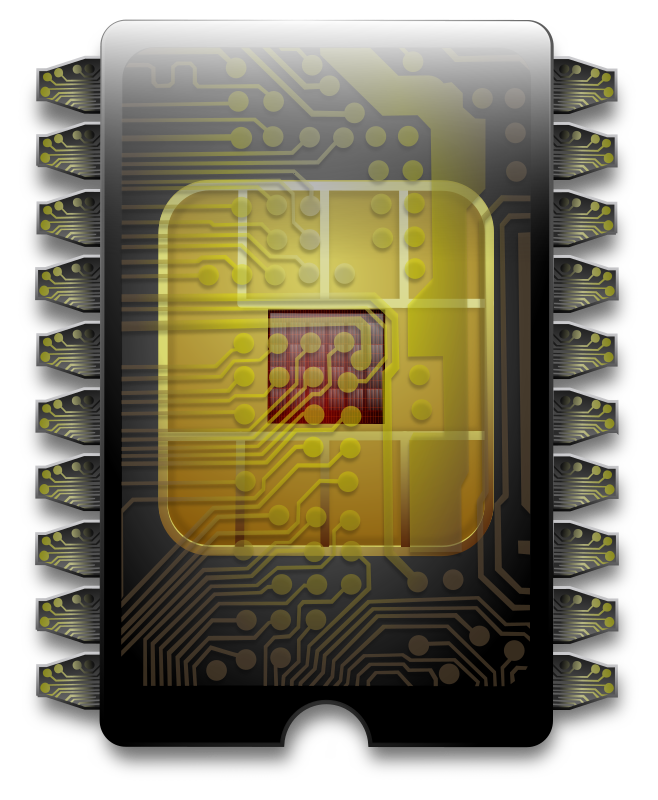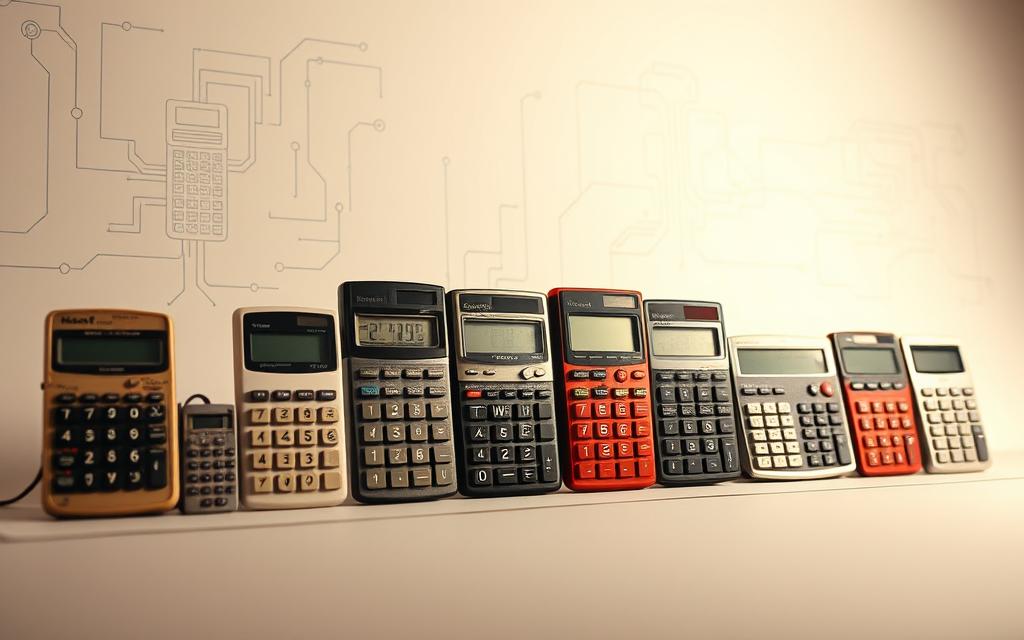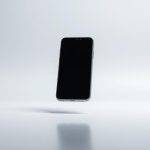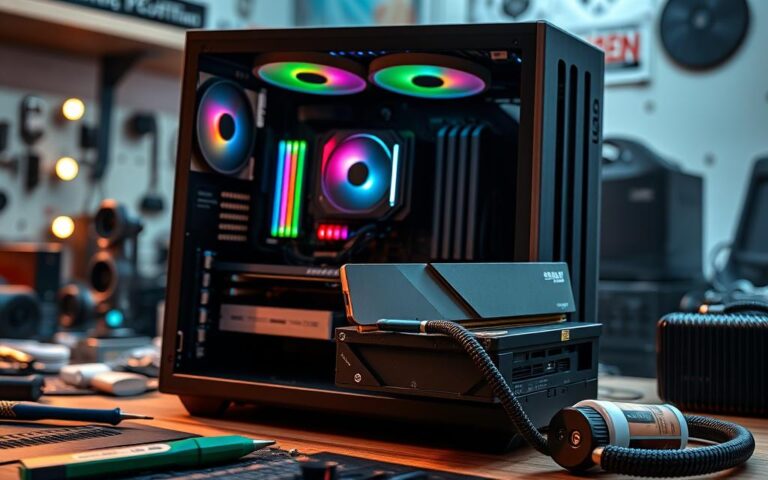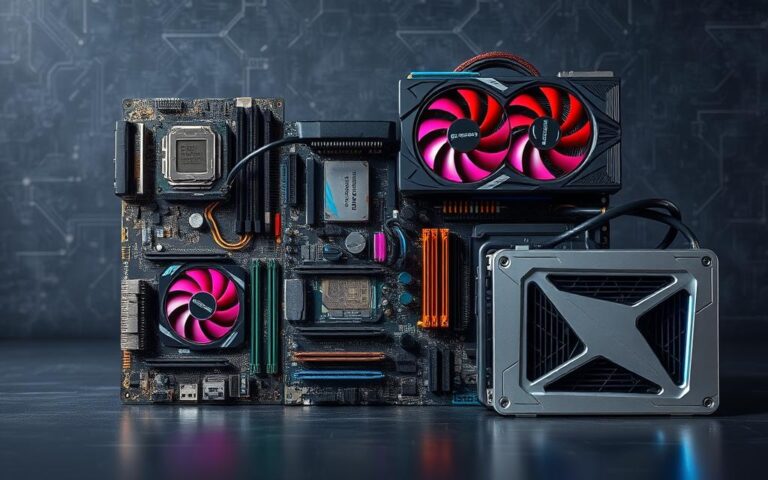Is a Calculator Technology The Evolution of a Basic Tool
Before silicon chips and touchscreens, people used beads and rods for math. The abacus, dating back to 2500 BC, was the first tool for numbers. It started a journey in computing technology history.
In the 17th century, machines like Blaise Pascal’s Pascaline changed math. These inventions moved math from manual to mechanical. The Industrial Revolution made these devices common, giving more people access to math tools.
The 20th century brought digital calculation tools that changed everything. Small chips made big machines small. As shown in key innovations in mechanical computation, each step made math faster, more accurate, and easier to use.
Today, our tools are far from their beginnings. Yet, they do the same job. From slide rules to apps on phones, our ability to work with numbers has grown. This shows how technology keeps evolving with our needs.
From Counting Stones to Mechanical Marvels
Over time, humans turned simple counting into complex machines. This change from basic tally sticks to machines with gears shows how people solved math problems before computers.
The Earliest Calculation Aids
Old societies made tools to help with trade and stars. The Sumerian abacus (3000 BCE) was the first digital tool, even though it was made of clay. Later, the Chinese made it better with bamboo and numbers.
Napier’s Bones and Logarithmic Breakthroughs
In 1617, John Napier changed math with his invention. His Napier’s Bones made hard math easy. This idea helped make slide rules, used until the 1970s.
17th-Century Engineering Milestones
The first mechanical calculators were inspired by clocks. Wilhelm Schickard made the first one in 1623. It had gears for math, but none exist today.
Pascal’s Pascaline Arithmetic Machine
Blaise Pascal made a machine in 1642 that could add and subtract. The Pascaline could do sums up to 9,999,900. It was a big step, but not very popular.
Leibniz’s Stepped Reckoner Multiplication Device
In 1674, Gottfried Leibniz made a machine that could multiply and divide. His stepped drum was a big improvement. It’s idea is used in today’s historical computation devices.
| Device | Year | Key Operation | Mechanism | Material |
|---|---|---|---|---|
| Pascaline | 1642 | Addition/Subtraction | Sautoir carry mechanism | Brass/Steel |
| Stepped Reckoner | 1674 | Multiplication/Division | Stepped drum cylinder | Copper/Bronze |
| Schickard’s Clock | 1623 | All basic operations | Interlocking gears | Wood/Metal |
These early machines were the start of modern computers. They showed how to solve math problems with machines, before the digital age.
Defining Technology: Is a Calculator Truly Technological?
To decide if calculators are truly technological, we must look at human creativity. Basic tools do one thing, but technology is about making things better over time. Calculators have improved a lot, showing they are truly technological.
Essential Characteristics of Technology
Tools and technology both help us do things, but they work in different ways. A tool needs us to use it directly, while technology uses knowledge to do things for us. Let’s look at three main points:
Tool vs Technology: Key Differentiators
- Physical manipulation vs programmed operation
- Immediate results vs processed outcomes
- Static design vs adaptive functionality
Information Processing as Technological Hallmark
Real technology changes what we give it into something new. Old calculators used gears, while today’s use binary logic. This shows how calculators have become true technology.
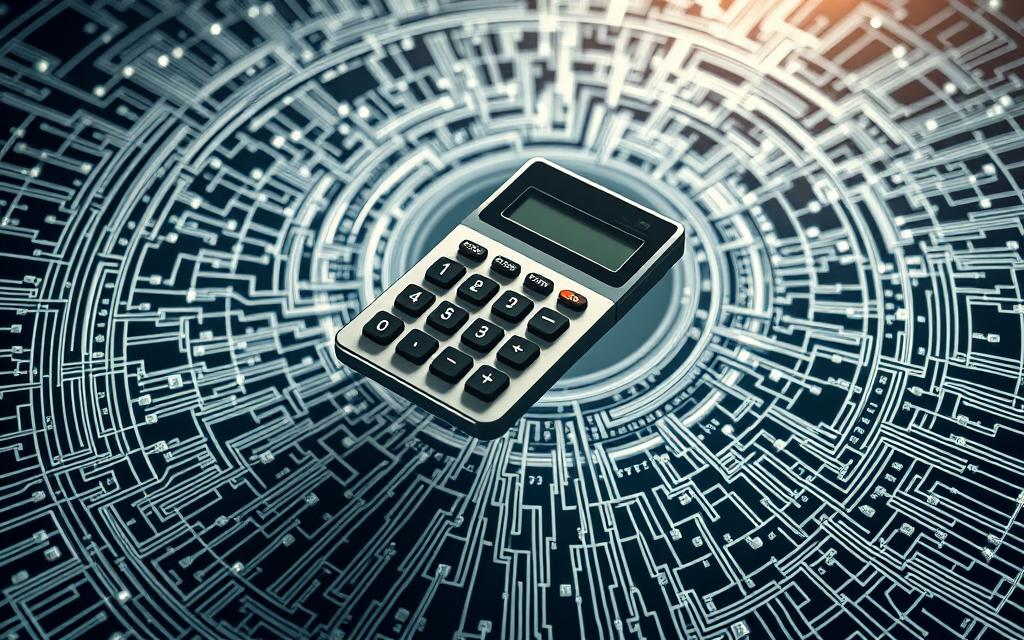
Calculator’s Technological Credentials
Calculators have become true technology through two main ways:
Material Evolution: Wood to Silicon
| Era | Material | Impact |
|---|---|---|
| 1600s | Wood/Brass | Mechanical precision |
| 1950s | Transistors | Electrical computation |
| 1970s | Silicon chips | Microprocessing |
Complexity Progression: Gears to Microchips
The IBM 608 in 1954 showed how materials science in computing helps things get more complex. Today, calculators are more powerful than huge computers from the 1960s. They do this with tiny circuits, not big machines.
Electronics Revolution
The move from mechanical to electronic calculators changed math forever. These devices started as huge machines and became small enough to fit in pockets. Key factors were transistors, smaller circuits, and better power solutions.
From Vacuum Tubes to Transistors
The 1946 ENIAC computer was a big step in vacuum tube technology. It was huge, weighed 27 tonnes, and used 150kW of power. Yet, it was 2,400 times faster than humans at ballistics calculations. But, it had 17,000 vacuum tubes that needed constant upkeep.
Bell Labs’ invention of the transistor changed everything. IBM’s 1954 604 Electronic Calculating Punch was a big leap, using transistors over tubes. It cost £83,000 and could do 60 operations per second. Britain’s ANITA MK-8 (1961) showed vacuum tubes could also be competitive with smart design.
Key Transition Milestones
| Technology | Year | Example | Size | Power |
|---|---|---|---|---|
| Vacuum Tubes | 1946 | ENIAC | 167m² | 150kW |
| Transistors | 1954 | IBM 604 | Desk-sized | 1.4kW |
| Hybrid | 1961 | ANITA MK-8 | Typewriter | 180W |
Handheld Breakthroughs
Texas Instruments’ 1967 Cal-Tech was a prototype that showed transistor calculators could be small. It was never sold but inspired Sharp’s 1971 QT-8B, the first battery-powered calculator.
The real breakthrough was in 1972 with Hewlett-Packard’s HP-35. It was called the “electronic slide rule” and cost £395. It could do complex math and was light enough for scientists and engineers to carry.
Portability Timeline
- 1967: Cal-Tech prototype (1.5kg)
- 1971: Sharp QT-8B (1.1kg)
- 1972: HP-35 (0.5kg)
Microprocessor Age
The 1970s brought a big change to calculators. Silicon chips replaced old mechanical parts. This made devices smaller and changed what we mean by portable computers.
Engineers had a big challenge. They had to make powerful computers small and affordable.
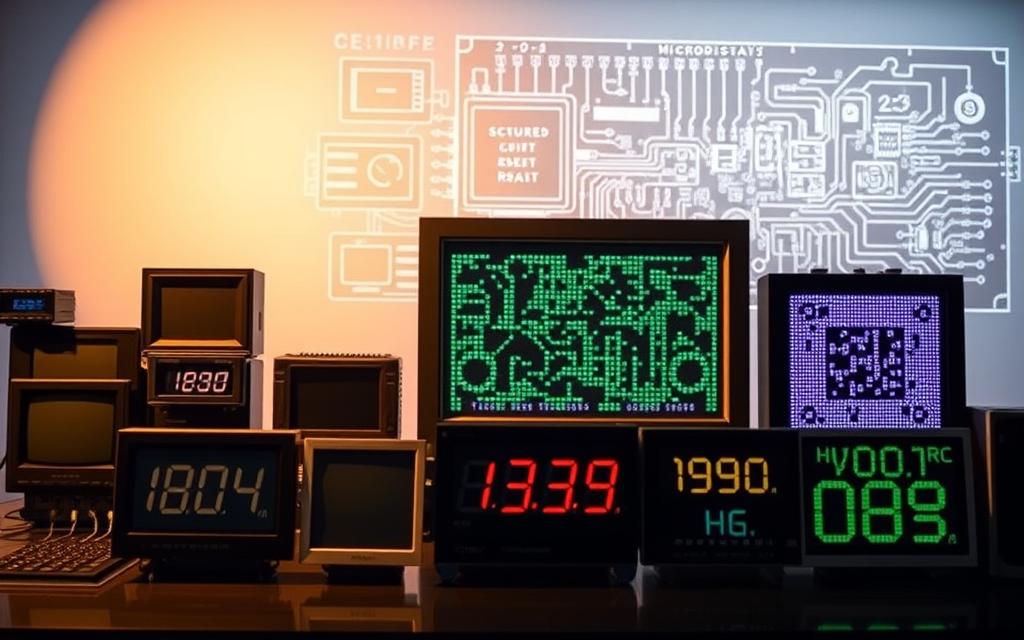
Integrated Circuit Advancements
Texas Instruments made a big leap in 1971. They created the “calculator on a chip”, called the TMS1802. This tiny chip powered the first pocket calculator with an LED display, the Busicom’s LE-120A “HANDY”.
Here are some key facts about this innovation:
| Model | Display | Weight | Price |
|---|---|---|---|
| Busicom LE-120A | Red LED | 200g | $150 |
| Pre-1971 models | Nixie tubes | 1.8kg | $800+ |
By 1975, making these chips cost 70% less. By 1976, simple calculators were under $20. This made them common in schools.
Texas Instruments’ 1971 Microcontroller
This single chip had 5,000 transistors in a small package. It made calculators:
- 60% smaller
- 75% less power-hungry
- easier to make in bulk
LCD Display Innovations
Sharp introduced the EL-805 in 1973. It was incredibly thin. Its twisted nematic LCD used much less energy than LEDs and worked well in sunlight.
Sharp EL-805 1973: Slim-Profile Engineering
The EL-805 was just 2.1cm thick. It was designed to be portable but easy to read. Its “credit card calculator” name caught people’s attention.
Solar Power Integration 1976
Teal Photon’s SR-1 in 1976 showed solar power could work for computers. It could run for 20 minutes on 1 hour of sunlight. This was a step towards today’s energy-saving tech.
Software Transformation
Calculators changed a lot with the rise of software. Now, devices like computers and phones can do complex math. This is thanks to code, not just gears.
Calculator Apps Emergence
Microsoft’s Windows 1.0 Calculator (1985) was a big step forward. It showed how simple math could be done with software, just like old transistors.
iOS/Android Default Apps Prevalence
Today, most phones come with apps for math. These apps are used by 83% of users every month. They can do things like split bills and convert units, better than old calculators.
Cloud Computing Integration
Now, we use the internet for big tasks. Wolfram Alpha checks out things like math problems and health info on the web. It even updates currency rates every 30 seconds.
Wolfram Alpha’s Computational Engine
This system works with huge amounts of data every day. It answers questions from simple math to complex science. It uses the internet to find answers, unlike old calculators.
| Feature | Local Processing | Cloud-Based |
|---|---|---|
| Speed | Instant basic operations | Millisecond delays for complex tasks |
| Data Access | Limited to stored memory | Real-time global databases |
| Updates | Manual software upgrades | Continuous automatic improvements |
Real-Time Currency Converters
Apps like XE use the internet for fast money changes. They work with blockchain to keep rates up to date. This is something old calculators couldn’t do.
Modern Technological Convergence
Calculators have come a long way from simple adders to today’s smart devices. Now, they work with artificial intelligence and augmented interfaces. This change affects how we use them every day and in schools.
Smart Device Integration
Calculators have moved beyond just buttons. They are now part of smart device computation. You can find them in kitchens and construction sites, working with voice commands and showing digital data.
Voice-Activated Calculations (Alexa/Siri)
Voice assistants can solve complex math problems with simple voice commands. Students can ask, “What’s 15% of 220?” during homework. Engineers can check their work without touching anything. This is great for people who can’t see well.
Augmented Reality Measuring Tools
Smartphone cameras can turn into precise rulers with AR apps like Measure. Contractors can measure rooms quickly, and biology students can see 3D models of molecules. All thanks to real-time computation algorithms.
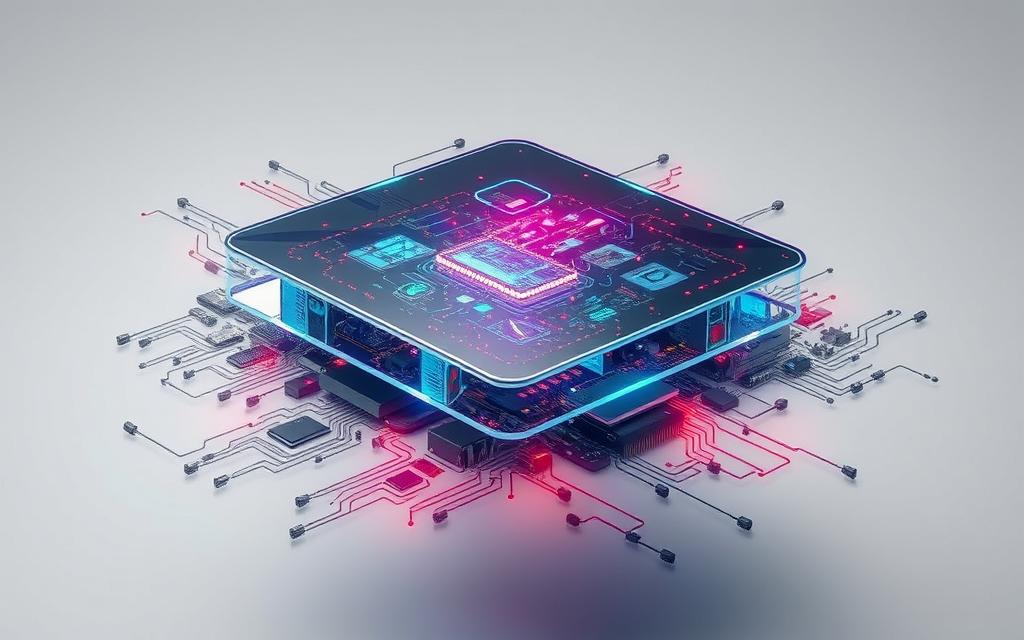
Educational Technology Impacts
Classrooms are where old calculators meet new apps. Devices like Casio’s PRIZM FX-CG50 are popular for their STEM tools. They have colour displays and can graph images, making complex math easier to understand.
Graphing Calculators in STEM Curricula
Casio’s PRIZM series is a hit in physics and chemistry classes. It can draw out parabolic paths and equilibrium graphs. Schools choose these calculators for exams because they are reliable, even though smartphones are everywhere.
Exam Board Controversies
There’s a big debate about why some calculators are allowed in exams but not smartphones. Some say devices like TI-Nspire CX II give students an unfair edge. But others think banning them makes learning less relevant to real life.
Future Computational Frontiers
New ways of calculating are coming from labs to change how we process data. They mix quantum physics with brain technology. This could solve problems that were thought to be too hard for computers.

Quantum Calculation Potentials
Quantum computers use qubit superposition for fast calculations. Unlike regular bits, qubits can handle many states at once. This helps in areas like secret codes and weather models.
Qubit-based Processing Advantages
Qubits offer several benefits:
- They can check many variables at once
- They’re great for complex simulations
- They use less energy than old computers
D-Wave Systems’ Commercial Applications
D-Wave is leading the way in using quantum computers. They help with planning supply chains and predicting finances. Their 5,000-qubit system is 3,000 times faster than old computers at solving big problems.
| Feature | Classical Computing | Quantum Computing |
|---|---|---|
| Processing Unit | Transistor-based bits | Qubits |
| Parallel Operations | Sequential | Simultaneous |
| Energy Consumption | High | Low |
Neural Interface Developments
Neural interfaces let us talk to machines with our minds. New versions are up to three times faster than typing.
Brain-Computer Interface Prototypes
These systems read brain signals for numbers. Now, we can do hard math just by thinking about it.
ETH Zurich’s Cognitive Load Studies
Researchers in Switzerland found a way to make thinking less tiring. Their tech changes based on how active your brain is. This cuts down mental fatigue by 40% during long tasks.
The Calculator’s Enduring Legacy in Human Innovation
From ancient Mesopotamia to today’s Texas Instruments, we’ve always sought better ways to count. Our journey shows how simple tools turned into key players in engineering, education, and science. Each step forward, like Pascal’s adder or HP’s first handhelds, shows our growing need for accuracy.
Now, we’re moving fast with quantum computers like IBM’s Osprey and Neuralink’s brain interfaces. These new tools might use quantum powers or read our brains, changing math forever. They build on centuries of progress, showing even simple tech can grow with us.
Today’s calculators, like Casio’s ClassPad and HP Prime, stay relevant with cloud access and touch screens. They help us see data and solve problems together, showing tech’s power to boost our abilities. With AI tools like Microsoft Math Solver, they keep bridging theory and practice.
Calculators show how basic tech can keep up with new discoveries in materials, electronics, and software. Their story is like humanity’s never-ending quest for knowledge, from counting crops to simulating the climate. What new wonders will tomorrow’s calculators bring, thanks to quantum and biotech?
FAQ
What were the earliest calculation tools preceding mechanical calculators?
The Sumerian abacus from 2500 BCE and its Chinese suanpan version were key. They were followed by Napier’s 1617 multiplication rods and Schickard’s 1623 clockwork mechanism. These introduced Europe’s first mechanical arithmetic.
How did Blaise Pascal’s Pascaline differ from Leibniz’s stepped drum calculator?
Pascal’s 1642 Pascaline used gears for addition and subtraction. Leibniz’s 1674 stepped drum allowed for multiplication through repeated addition. Leibniz’s design was more complex, handling numbers automatically.
What technological criteria establish calculators as legitimate technology?
Calculators are technology because they are purpose-built for math, transform inputs into solutions, and use advanced materials. IBM’s 608 (1954) is a prime example, with 3,000+ germanium components.
How did transistor technology revolutionise calculator development?
The £83,000 IBM 608 (1957) used transistors for faster calculations. This was a big leap from Bell Punch’s 1961 ANITA, which had 160 vacuum tubes and reliability issues.
What breakthroughs enabled handheld calculator designs?
Texas Instruments’ 1967 Cal-Tech showed the power of integrated circuits. Sharp’s 1973 EL-8051 was the first truly portable with LCD displays. Hewlett-Packard’s 1974 HP-65 was small and programmable.
How have software solutions altered calculator usage patterns?
Microsoft’s Windows Calculator (1990) marked a shift to digital. Now, Wolfram Alpha’s cloud engine handles complex tasks like binary conversions, making physical devices less necessary.
Why do Casio and Texas Instruments dominate educational markets?
Casio’s Casio PRIZM and TI-Nspire CX II meet strict exam rules, unlike smartphones. This sparks debates on fairness in calculations.
Could quantum computing render traditional calculators obsolete?
ETH Zurich’s quantum work shows high accuracy. Yet, quantum systems are not practical for everyday calculations. Neural interfaces might change how we interact with numbers.
What energy efficiency milestones shaped calculator evolution?
Sharp’s 1976 EL-8002 lasted 100 hours with CMOS and LCD. This led to solar-powered calculators, unlike early LED displays that used a lot of power.
How do exam regulations address modern calculator capabilities?
UK exams have rules for calculators. GCSEs allow basic functions, while A-Levels have more advanced options. Manufacturers offer exam modes to disable certain features.
